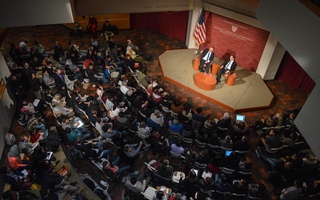Three percent sounds like a small number, but it is not quite that tiny when discussing economic growth. Considering we had a gross domestic product of 18.46 trillion dollars at the end of 2016, even the smallest percentage fluctuation is significant. Currently, the U.S. economy’s growth rate is wavering around 2 percent.
President Trump claimed throughout his campaign that he could help our economy hit that 3 percent. He has even gone as far to say that we can hit 4, 5, or even 6 percent growth. Yes, between 1948 and 2005, our annual economic growth rate had hit 3 percent two-thirds of the time. But since 2005, it has not risen above 2.7 percent. Additionally, the Congressional Budget Office and other forecasters are predicting an average economic growth rate over the next decade that won’t even hit 2 percent.
Why does Trump want a higher economic growth rate? Well, the White House claims that if we do not reach 3 percent productivity, the “budget will never balance.” Trump has used the assumption that the United States can reach 3 percent annual economic growth in his crafting of the administration’s 62-page budget proposal. Before anyone can realistically predict the suitability or effectiveness of Trump’s budget proposal, however, we first should be fairly confident in our economic growth rate increasing to 3 percent. That’s highly unlikely to happen.
Let’s look at what is driving declining growth rates. We can point towards the size of the active labor force and its productivity. The size of the participating U.S. labor force is slowly shrinking. This is in part due to the aging baby boomer generation retiring. The labor force participation rate has also been decreasing for both working-age males and females, and had started declining before the Great Recession.
Another factor is immigration. According to the Pew Research Center, if we cannot get 18 million more people to immigrate to America in the future, the size of our working-age population will continue to diminish. Trump’s push to implement travel bans isn’t helping his own goal of increasing the economic growth rate. Furthermore, in January of this year Federal Reserve Chair Janet Yellen said the economy is “near maximum employment.”
So we know that the outlook on the size of the workforce isn’t positive. How about the chances of innovative or technological potential to support a boom in economic growth? According to Robert J. Gordon of Northwestern University, these odds are not good either, saying that we’ve already reached the end of a long technology cycle and that the “low-hanging fruit of innovation-driven gains has been picked.”
He believes that robots, artificial intelligence, big data, autonomous cars, and other innovative ideas have already “been oversold” into the current economy, making a negligible difference in productivity. So if we want another boost to our economy, we might have to find new avenues of innovation. We can’t predict if or when we’ll discover new technology, so we shouldn’t base our hopes for large economic growth on innovation.
A big obstacle to Trump’s 3 percent goal may be Trump himself. In addition to his immigration proposals, Trump has proposed other policies that are obstacles to economic growth. In addition to the size of the active labor force and the potential of innovation and technology, another booster of economic growth and productivity is increased human capital. Some of Trump’s proposed policies cut back on programs or measures that work on increasing human capital.
Trump wants to cut training programs and federal student loan subsidies that could boost workers’ contribution to economic productivity. He also wants to cut government spending on research and other educational programs that would theoretically teach relevant skills and knowledge to individuals who’d enter the workforce and increase human capital. Of course, it’s important to see if the programs Trump wants to cut are actually doing an effective job in increasing human capital. We should be discussing not only program funding but also the effectiveness of the methods and procedures the programs use to increase human capital.
We cannot say for sure whether or not our economy will hit or sustain a growth rate of 3 percent. After all, most economists expected neither the 1973 downturn nor the 1995 upturn. We cannot predict whether a miracle event or forgotten factor may come along and boost our growth. However, it seems unlikely that we will hit that golden 3 percent in the near future.
Lydia Wang ’20 is a Crimson business editor in Kirkland House. Her column appears on alternate Wednesdays.
Read more in Opinion
A Second Look at Cultural ImperialismRecommended Articles
-
 Obama Colleagues Summers and Furman Talk Economic Growth
Obama Colleagues Summers and Furman Talk Economic Growth -
 Elizabeth Warren Promotes Book in Boston
Elizabeth Warren Promotes Book in Boston -
Imagining InstabilityCompared to other regions in the U.S., the Midwest more than adequately subsists on its economic output. Yet Midwesterners still feel as though they lack something in comparison to the rest of the country, and perhaps rightly so.
-
 Iceland President Visits Harvard, Speaks on #MeToo
Iceland President Visits Harvard, Speaks on #MeToo -
Eighty-Eight Percent of Surveyed Harvard Faculty Believe Trump Has Done a ‘Very Poor’ Job as President













